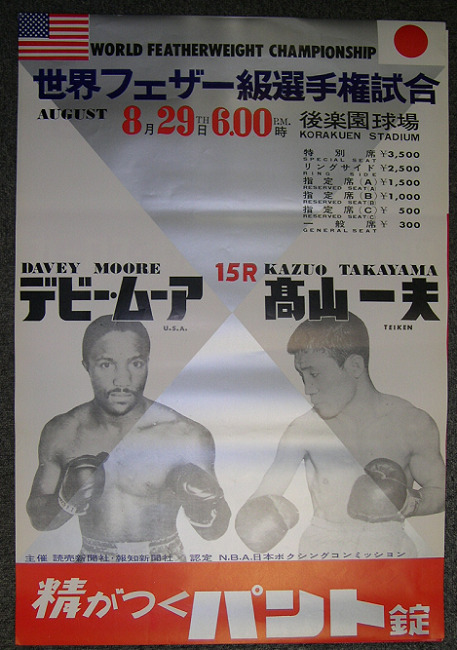Nat’l H.S. boxing selection tourney cancel for second straight year
Feb 17, 2021 9:35 am
Feb 15, 2021 10:17 am
Hinata Maruta of Morioka Boxing Gym has become the Japanese featherweight champion by stopping Ryo Sagawa of Misako Boxing Gym in a recent fight.

Whenever I hear the name a Japanese featherweight champion, it reminds me of the late Japanese featherweight champion Kazuo Takayama of Teiken Gym. Can Maruta beat Takayama?
There is no doubt Takayama was one of the toughest boxers in the Japanese boxing history.
Takayama, who came to be known for his white trunks and white boxing shoes, had a tremendous punching power although his record of ‘’only’’ 24 knockouts and technical KOs out of 59 wins, may be puzzling for today’s boxing fans. He suffered 16 losses, nine draws and seven exhibitions.
In today’s fight when a boxer is knocked down once and wobbles along the ropes after getting up while withstanding his opponent’s onslaught, a referee tends to stop the bout to declare a TKO.
In the days when Takayama was most active, (in the late 1950s and early 1960s), you have to really knock out your opponent. In other words, a referee never stopped a fight in a situation mentioned above.
Even when a boxer was reeling along the ropes after suffering a knockdown, the referee let the fight go on until his opponent scored another clean knockdown. Then, depending upon the degree of the fallen boxer’s damage, the referee either stopped the fight or let the fight continue. I saw many damaged boxers achieve the come-from-behind KOs with their desperate punches.
The flat-footed Takayama was not good at catching up with his damaged but escaping foes. I think it is not far-fetched to believe Takayama would have amassed some 10 more KO wins under Today’s standards.
Takayama’s toughness was best shown in his nontitle fight against then world lightweight champion Carlos Ortiz of Puerto Rico, who wanted to have a nontitle bout before his title defense against Oriental Boxing Federation lightweight champion Teruo Kosaka, Takayama’s stablemate, in Tokyo in November 1962.
While Ortiz hit Takayama almost at will, Takayama, an embodiment of toughness, lasted the 10 full rounds. One month later Ortiz knocked out Kosaka without much ado. After the fight, Ortiz said Takayama was much stronger than Kosaka.
Takayama himself unsuccessfully challenged world featherweight champion Davey Moore of the United States twice and had to settle for defending his Japanese title because his stablemate Hisao Kobayashi was the OBF champion.
At that time, there were only eight weight divisions in the world ranging from flyweight to heavyweight with only one sanctioning body. It was as simple as that.
Today, there were as many as 17 divisions with four sanctioning bodies. There are interim champions, super champions, champions in recess, franchise champions etc.
Then, in March 1963, Takayama fought OBF junior lightweight champion Yukio Katsumata in a nontitle bout. Takayama decked Katsumata twice in the fourth round, which could have been declared Takayama’s TKO win in today’s standard.
But in the sixth stanza, Katsumata’s desperate overhand right put Takayama down hard to the canvas. Although Takayama struggled to his feet, he was wobbling in the ring and was then reeling along the ropes until the referee finally declared Takayama’s KO loss. Before the fight, they had fought three times with Takayama losing two of them mostly in his early career.
But amazingly, Takayama returned to the ring only 38 days later. Today, the Japan Boxing Commission’s rule has it that a boxer who suffers a KO or TKO loss cannot fight at least for the next 90 days.
Takayama attained five straight victories before taking on lightly regarded Larry Fernando of the Philippines, whom Takayama knocked out twice before.
In the fight, Takayama floored the Filipino early in the bout, and most people watching the fight, including myself, thought it was just a matter of time before Takayama’s KO victory. But he suddenly stopped throwing punches while moving back and forth in front of his damaged opponent.
We thought Takayama was taking a wait-and-see attitude on purpose. But this bizarre scene continued for the next several rounds when the referee and Takayama’s seconds finally realized something wrong was happening to him and stopped the fight early in the ninth round. If the fight had continued, Takayama might have suffered severe brain damage.
That was his final bout. He then had to retire at the age of 27 years old.
All in all, Takayama was born some 60 years too early. (written by Masaya Kokubu, free writer)
Feb 17, 2021 9:35 am
Feb 12, 2021 10:56 am
Apr 22, 2024 21:11 pm
Apr 22, 2024 8:57 am
Apr 21, 2024 19:28 pm
Apr 21, 2024 16:54 pm
Apr 20, 2024 10:06 am